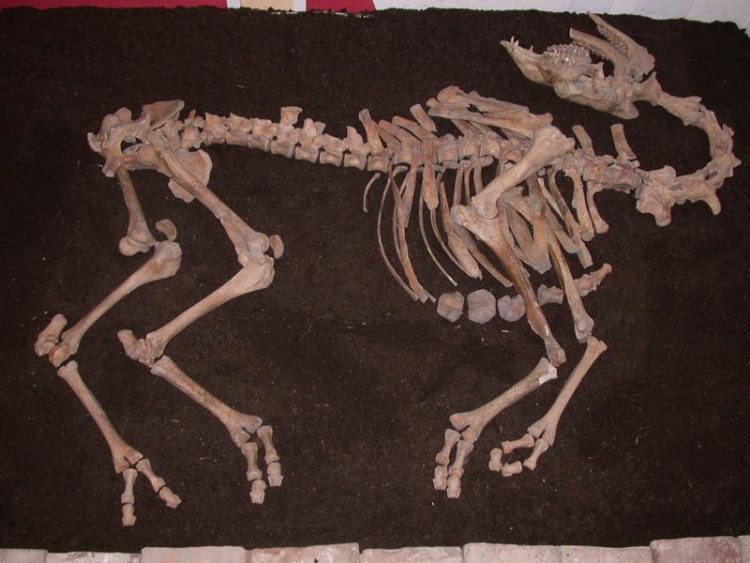Complete camel skeleton unearthed in Austria

The camel skeleton was unearthed near the river Danube in Lower Austria, Tulln. Photo: Alfred Galik/Vetmeduni Vienna
In 2006 construction began on a new shopping centre in Tulln. The works unearthed various archaeologically valuable objects that were salvaged during rescue excavations. Among these objects was also the complete skeleton of a large mammal.
Large mammal uncovered during excavations in Tulln
“The partly excavated skeleton was at first suspected to be a large horse or cattle,” says archaeozoologist Alfred Galik from the Institute for Anatomy, Histology and Embryology at the University of Veterinary Medicine Vienna. “But one look at the cervical vertebrae, the lower jaw and the metacarpal bones immediately revealed that this was a camel.”
Camel bones have been found in Europe dating back to the Roman period. Isolated bones or partly preserved skeletons are known from Mauerbach near Vienna as well as from Serbia and Belgium. But a complete camel skeleton is unique for Central Europe.
“Exotic animal” died in Tulln
In addition to horses, the Ottoman army also used camels for transportation and as riding animals. In cases of scarcity, the soldiers also ate the animal’s flesh. But the skeleton found in Tulln was complete. “This means that the animal was not killed and then butchered. It may have been acquired as part of an exchange,” says first author Galik. “The animal was certainly exotic for the people of Tulln. They probably didn’t know what to feed it or whether one could eat it. Perhaps it died a natural death and was then buried without being used.”
Camel was a hybrid
Extensive DNA analysis showed that the animal was a hybrid: its mother was a dromedary and its father a Bactrian camel. The genetic diagnosis confirmed what the scientists saw morphologically. Several of the physical features were that of a dromedary, others of a Bactrian camel. “Such crossbreeding was not unusual at the time. Hybrids were easier to handle, more enduring and larger than their parents. These animals were especially suited for military use,” Galik explains.
The camel was male, around seven years old and most likely castrated.
Find dated to the 17th century
Besides animal bones, the excavations also unearthed ceramic plates and other items. A coin – a so-called “Rechenpfenning” – from the time of Louis XIV dates the find to the years between 1643 and 1715. A medicinal bottle containing Theriacum, a medieval remedy from the chemist’s shop “Apotheke zur Goldenen Krone” in Vienna was also found at the site. This pharmacy existed between 1628 and 1665, which helped date the site with further precision.
Service:
The article „A sunken ship of the desert at the river Danube in Tulln, Austria“, by Alfred Galik, Elmira Mohandesan, Gerhard Forstenpointner, Ute Maria Scholz, Emily Ruiz, Martin Krenn and Pamela Burger was published in the scientific journal PLOS ONE. DOI 10.1371/journal.pone.0121235 http://dx.plos.org/10.1371/journal.pone.0121235
About the University of Veterinary Medicine, Vienna
The University of Veterinary Medicine, Vienna in Austria is one of the leading academic and research institutions in the field of Veterinary Sciences in Europe. About 1,300 employees and 2,300 students work on the campus in the north of Vienna which also houses five university clinics and various research sites. Outside of Vienna the university operates Teaching and Research Farms. http://www.vetmeduni.ac.at
Scientific Contact (archaeozoology):
Dr. Alfred Galik
Institute of Anatomy, Histology and Embryology
University of Veterinary Medicine Vienna (Vetmeduni Vienna)
T +43 1 25077-2521
alfred.galik@vetmeduni.ac.at
Scientific Contact (genetics):
Elmira Mohandesan, PhD
Institute of Population Genetics
University of Veterinary Medicine Vienna (Vetmeduni Vienna)
T +43 681 815 033 12
elmira.mohandesan@vetmeduni.ac.at
Released by:
Susanna Kautschitsch
Science Communication / Public Relations
University of Veterinary Medicine Vienna (Vetmeduni Vienna)
T +43 1 25077-1153
susanna.kautschitsch@vetmeduni.ac.at
http://www.vetmeduni.ac.at/en/infoservice/presseinformation/press-releases-2015/…
Media Contact
All latest news from the category: Earth Sciences
Earth Sciences (also referred to as Geosciences), which deals with basic issues surrounding our planet, plays a vital role in the area of energy and raw materials supply.
Earth Sciences comprises subjects such as geology, geography, geological informatics, paleontology, mineralogy, petrography, crystallography, geophysics, geodesy, glaciology, cartography, photogrammetry, meteorology and seismology, early-warning systems, earthquake research and polar research.
Newest articles

High-energy-density aqueous battery based on halogen multi-electron transfer
Traditional non-aqueous lithium-ion batteries have a high energy density, but their safety is compromised due to the flammable organic electrolytes they utilize. Aqueous batteries use water as the solvent for…

First-ever combined heart pump and pig kidney transplant
…gives new hope to patient with terminal illness. Surgeons at NYU Langone Health performed the first-ever combined mechanical heart pump and gene-edited pig kidney transplant surgery in a 54-year-old woman…

Biophysics: Testing how well biomarkers work
LMU researchers have developed a method to determine how reliably target proteins can be labeled using super-resolution fluorescence microscopy. Modern microscopy techniques make it possible to examine the inner workings…





















